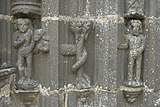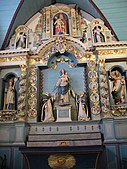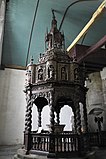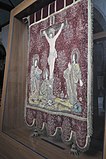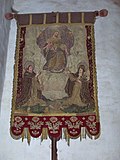St-Miliau (Guimiliau)
The Catholic parish church of Saint-Miliau in Guimiliau , a community in the Finistère department in the French region of Brittany , was built in the 16th and 17th centuries in the transition from Flamboyant Gothic to Renaissance . The church is dedicated to St. Miliau , a legendary Breton saint. The church has rich furnishings and a stained glass window from the mid-16th century. In 1906 the church, which belongs to an enclosed parish with a surrounding wall, triumphal gate , Calvaire and two ossuaries , was added to the list of architectural monuments ( Base Mérimée ) in France as Monument historique .
architecture
Exterior construction
On the west facade is the rectangular bell tower, the oldest part of the church. It was built in the early 16th century in the so-called Beaumanoir style , named after a family of builders who built numerous churches in Brittany in the Flamboyant Gothic style. A round stair tower with a spiral staircase is built on its south side, which leads to the bell floor. The corners of the tower are reinforced by buttresses that extend to the bell storey and on which a balustrade is placed. The tum is crowned by an octagonal, stone point. A portal framed by a keel arch has been cut into the ground floor of the tower .
The portal on the north side of the nave is marked with the year 1673. It was the death gate and originally led to the cemetery. On the south side of the choir is the sacristy grown. The granite building, a rotunda with four apses, was built between 1676 and 1683 over a clover-leaf-shaped floor plan.
The small annex on the west side of the vestibule also served as an ossuary , like the independent Sainte-Anne chapel .
lobby
The southern vestibule, which was built between 1606 and 1617, is covered by a ribbed vault with hangers . In the vestibule, under elaborately carved canopies, are the figures of the twelve apostles. Under the figures of the apostles you can see reliefs with figurative scenes such as the creation of Eve or the expulsion of a demon.
A granite holy water font is attached to the central pillar between the two doors of the inner porch . It was created in 1602 and consists of a gadronized bowl on which an angel kneels and a canopy, which is decorated with a rich decor of heads and ornaments. Above the portal is the figure of Christ giving blessings, surrounded by Adam and Eve and the busts of a man and a woman.
The outer portal of the vestibule is framed by archivolts with numerous figures and biblical scenes. At the bottom, right and left of the portal, Adam and Eve can be seen, on the left, at the beginning of the arch, the birth of Christ and on the right, the Visitation .
inner space
The entire interior has wooden ceilings. High pointed arches , which rest on columns without capitals , open from the main nave to the side aisles. The north aisle was enlarged in 1633, the south aisle doubled in 1642 by adding chapels. The false transept , created by adding chapels, and the choir closed on five sides were completed in 1664.
Crucifixion window
The central choir window, the crucifixion window, with the depiction of the crucifixion of Christ and the descent from the cross is dated around 1550.
Altars
The three altars of the church, the Rosary Age, the Joseph Altar and the Altar of St. Miliau date from the 17th century.
- In the center of the rosary altar stands Mary, who presents the rosary to St. Dominic and St. Catherine of Siena. The secrets of the rosary are depicted on the 15 medallions that surround the scene. In the side niches you can see St. Zacharias and St. Nicholas of Myra . In the altar extension, God the Father is enthroned with the body of Jesus on his lap, angels stand in the side niches.
- In the middle of the altar of St. Miliau stands the figure of the church patron. The side relief panels depict scenes from his life, the predella panels show his martyrdom.
- The Joseph altar shows Saint Joseph with the boy Jesus by the hand. The side figures are St. Anna and St. Elisabeth , in the altar extract you can see St. Laurentius with his attribute , the grill.
Further equipment
- The wood-carved pulpit is marked with the year 1677. The pulpit rests on a base with four angel figures and is decorated with medallions on which the four evangelists are depicted with their symbols . The female figures at the corners represent the cardinal virtues .
- The carved oak canopy over the baptismal font was created in 1675. It rests on twisted columns with Corinthian capitals and is decorated with numerous figures. The group of figures on the cupola of the canopy represents the baptism of Jesus. The scene is covered by a double lantern , which is crowned by an angel.
- The church has two processional flags from the 17th century. The flags are silk embroidery with gold and silver threads. On the front of a flag you can see a crucifixion group and on the back the holy Miliau , the church patron. The other flag depicts Mary presenting the rosary to St. Dominic and St. Catherine of Siena , the reverse is dedicated to St. Paulinus Aurelianus .
organ
The organ was made by the organ builder Thomas Dallam at the end of the 17th century. The instrument was rebuilt several times in the 19th century.
literature
- Le Patrimoine des Communes du Finistère . Flohic Éditions, Volume 1, Paris 1998, ISBN 2-84234-039-6 , pp. 631-635.
- Françoise Gatouillat, Michel Hérold: Les vitraux de Bretagne . (= Corpus Vitrearum ). Volume VII, Presses Universitaires de Rennes, Rennes 2005, ISBN 2-87535-0151-3 , pp. 136-137.
- Brittany . Hachette, Guides Bleus, Paris 1991, ISBN 2-01-015841-5 , p. 332.
Web links
- Église Saint-Miliau infoBretagne.com (French, accessed April 13, 2020)
- Église Saint-Miliau Observatoire du Patrimoine Religieux (French, accessed April 13, 2020)
- Guimiliau - Enclos paroissial Saint-Miliau Sauvegarde du Patrimoine Religieux en Vie (French, accessed April 13, 2020)
Individual evidence
- ↑ Église Saint-Miliau in the Base Mérimée of the French Ministry of Culture (French)
- ↑ Holy water font in the Base Palissy of the French Ministry of Culture (French)
- ^ Rosary Age, Joseph Altar, Altar of St. Miliau in the Base Palissy of the French Ministry of Culture (French)
- ↑ Pulpit in Base Palissy of the French Ministry of Culture (French)
- ↑ Canopy over the baptismal font in Base Palissy of the French Ministry of Culture (French)
- ↑ Processional flag in the Base Palissy of the French Ministry of Culture (French)
- ↑ Processional flag in the Base Palissy of the French Ministry of Culture (French)
- ^ Organ in the Base Palissy of the French Ministry of Culture (French)
- ^ Organ (instrument) in the Base Palissy of the French Ministry of Culture (French)
- ^ Organ prospectus in the Base Palissy of the French Ministry of Culture (French)
Coordinates: 48 ° 29 '18.6 " N , 3 ° 59' 51.4" W.











